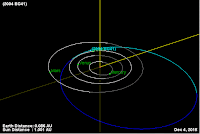Asteroid 2015 WB13 passed by the Earth at a distance of 18 950 000 km (49.3 times the average distance between the Earth and the Moon, or 12.7% of the average distance between the Earth and the Sun), at about 8.55 pm GMT on Thursday 3 December 2015. There was no danger of the asteroid hitting us, though had it done so it would have presented a genuine threat. 2015 WB13 has an estimated equivalent diameter of 82-260 m (i.e. a spherical body with the same mass would be 68-260 m in diameter), and an object towards the upper end of this range would pass through the atmosphere and directly impact the ground with a force of about 2000 megatons (about 118 000 times the explosive energy of the Hiroshima bomb), causing devastation over a wide area and creating a crater over 5 km across, and resulting in global climatic problems that could last for decades or even centuries.
2015 WB13 was discovered on 30 November 2015 (three days before its closest approach to the Earth) by the University of Arizona's Catalina Sky Survey, which is located in the Catalina Mountains north of Tucson. The designation 2015 WB13 implies that it was the 327th asteroid (asteroid B13) discovered in the first half of November 2015 (period 2015 W).
2015 WB13 has an 1742 day orbital period and an eccentric orbit tilted at an angle of 37.8° to the plane of the Solar System that takes it from 1.06 AU from the Sun (i.e. 106 % of the average distance at which the Earth orbits the Sun) to 4.60 AU from the Sun (i.e. 460% of the average distance at which the Earth orbits the Sun, slightly over three times the distance at which the planet Mars orbits). It is therefore classed as an Amor Group Asteroid (an asteroid which comes close to the Earth, but which is always outside the Earth's orbit).
See also...
 Geminid Meteor Shower should be clearly visible this year. The Geminid Meteor Shower is expected to peak on Sunday 13-Monday 14
December this
year (2015) with potentially up to 120 meteors per hour being visible in
areas of the Northern Hemisphere with a clear sky...
Geminid Meteor Shower should be clearly visible this year. The Geminid Meteor Shower is expected to peak on Sunday 13-Monday 14
December this
year (2015) with potentially up to 120 meteors per hour being visible in
areas of the Northern Hemisphere with a clear sky... Asteroid 2004 XK14 passes the Earth. Asteroid
2004 XK14 passed by the Earth at a distance of 14 720 000 km (38.3 times
the average distance between the Earth and the Moon, or 0.84% of the
average distance between the Earth and the Sun), slightly after 7.40 pm
GMT on Friday 28...
Asteroid 2004 XK14 passes the Earth. Asteroid
2004 XK14 passed by the Earth at a distance of 14 720 000 km (38.3 times
the average distance between the Earth and the Moon, or 0.84% of the
average distance between the Earth and the Sun), slightly after 7.40 pm
GMT on Friday 28... Asteroid 2004 BG41 passes the Earth. Asteroid
2004 BG41 passed by the Earth at a distance of 11 530 000 km (30
times the average distance between the Earth and the Moon, or 7.7% of
the average distance between the Earth and the Sun), slightly before
8.30 am on Friday November 2015. There was no...
Asteroid 2004 BG41 passes the Earth. Asteroid
2004 BG41 passed by the Earth at a distance of 11 530 000 km (30
times the average distance between the Earth and the Moon, or 7.7% of
the average distance between the Earth and the Sun), slightly before
8.30 am on Friday November 2015. There was no...
Follow Sciency Thoughts on Facebook.

